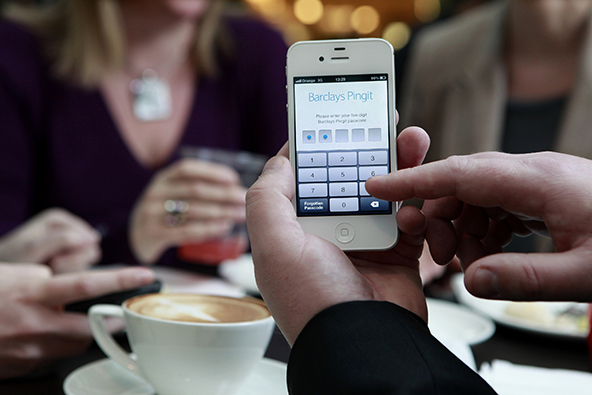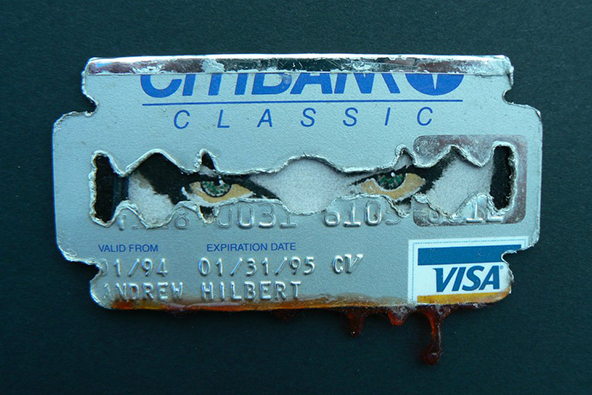Barclays Pingit Shows why Dwolla-like Start-ups Stand no Chance

I’ve wanted to write about this subject for quite some time and this morning I was given the opportunity I’ve been waiting for. Last year we received a lot of pushback for our post about Dwolla, a person-to-person (P2P) mobile payments provider. Many readers didn’t like our conclusion that the start-up simply stood no chance as a stand-alone service, because the big banks would, sooner rather than later, come up with a very similar service and would be offering it for free.
Well, Barclays, a big British bank, has just launched Pingit — a P2P mobile payments service that allows Britons to send and receive money through their phones, for free. Consumers without a Barclays account can only receive payments, but the bank promises that they would “soon be able to send money too.” I don’t know about you, but that sounds to me like a description of what Dwolla does, up to the pricing thing. And if Barclays is doing it, its American cousins will be doing it soon enough too.
Dwolla’s Problem
Let me re-post our take on Dwolla’s prospects, as we saw them in July of last year:
But it is something else that makes me really question the future of Dwolla and similar services and curiously I haven’t read about it anywhere – the fees they charge. At $0.25 per transaction, you would need many millions of them to make any kind of profit that would justify the effort. A million transactions, which could be what the start-up is currently processing monthly, only translate into $250,000 in revenues. The problem is that Dwolla cannot charge more than that; banks are doing it for free!
The Takeaway
I am quite skeptical about Dwolla’s prospects. I just don’t think that its business model, in its present form, would allow the start-up to achieve any significant scale. Their only chance, as I see it, is to quickly sign up as many banks as they can (Dwolla says they have currently signed up 15) and let them use their technology. The problem is that banks are already developing their own system and JPMorgan Chase, Bank of America and Wells Fargo have said that clearXchange will be open to other banks. To make matters worse for Dwolla, PayPal is spending heavily on its own P2P platform and it already has built a huge customer base and online presence.
So I think that the start-up should prepare itself for a long, hard slog.
I don’t think that I would’ve changed a word in the above paragraphs, if I had to write them with the benefit of today’s perspective.
Today’s Perspective
Many readers of our original Dwolla post repeatedly told us how great the company’s service was and I have no reason to doubt that assertion. In fact, we did congratulate the start-up on their fast growth, especially considering the fact that they reached $1 million in daily transaction volume in a shorter amount of time than it took the far-better funded and publicized Square. That was a great achievement and ours was not a backhanded compliment.
All that, however, doesn’t take anything away from the fact that Dwolla, unlike Square, has set out to compete in a sector that banks care very much about. What makes Square so successful is not its technology, which has been easily replicated by Intuit GoPayment and many others, but rather its business model. See, before Square only businesses could accept credit cards for payment. Banks simply didn’t offer the service to consumers. Jack Dorsey’s company changed all that and was the first one to enable everyone to take cards.
P2P bank transfers, which are what Dwolla facilitates, are different. This is bank-backyard territory and banks have been providing various such services for a long time and for free, although transfers have so far only been possible between customers of the same bank. Dwolla, of course, took it a step further by facilitating P2P transfers between different banks and by funding the recipient’s account instantaneously. But that’s not enough of a competitive advantage, as the Barclays example makes clear.
The Takeaway
So Dwolla is still facing an uphill climb, only that the company now has less time to get to the top. But what would a successful climb look like for Dwolla? Last year we contended that their only chance was to sign up as many banks as they could and let them use their platform. In essence, that would turn them into a technology company, not a payments one.
I still think that this would be the best, and very possibly the only positive, outcome for the start-up. Dwolla could be doing that as an independent company or, which is the much more likely scenario, it could be acquired by a bank, which would use its system. That would not necessarily be a bad exit for the Dwolla guys. In fact, if they time it right, it could be a very lucrative one indeed.
Image credit: Barclays.



Thanks for your post ?Çô it was very informative ?Çô and it just shows how much your services need to offer for that competitive edge.
Although Barclays Pingit?ÇÖs success has really taken off, I find it interesting to look at other forms of payment/similar services that have been attempted prior to this.
One of them we discussed, which may be of interest to you, is Mpesa- which is a payment transfer service that has been active in Tanzania, Kenya and Afghanistan since 2007 (http://379.at/vVgH) and in many ways is already a step further than Pingit (this is because you can transfer money by text to anyone ?Çô including taxi drivers/shop for example, and then the receiver can pick up money from local vendors by providing the code that was text). It just shows the potential mobile has within the finance sector.
Lindsay,
I have been following M-Pesa and I agree, it is a great story. It?ÇÖs been a while since we wrote about it ?Çô the last article we published on M-Pesa was in November 2010 ?Çô but you are right, there is a lot to be learned there.
As a nerd immersed in the both the gritty culture of Chicago and the lofty world of new technology and how it applies to startups, I think you might be underestimating one important aspect relating to dwolla?ÇÖs success: it?ÇÖs attempts to develop an application friendly to developers and simultaneously increasing the security procedures to aid in decreasing fraud.
For example, Paypal?ÇÖs IPN (Instant Payment Notification) information provided in callback to my applications can vary from 10 to nearly 30 different pieces of information (which change depending on the transaction/cart type). Dwolla has 7 pieces of information in their payment notifications ?Çô the same ones, every time. And they have made it clear that their goal is to make Dwolla easy for developers, and at $0.25 per transaction, they are a great solution for businesses looking to cut costs. Take a $1 million annual restaurant with an approximated 50% of sales via credit card and you have an annual cost of somewhere on the order of $15,000 for credit card processing alone. Why wait around for a free solution from Chase & Bank of America [and maaaybe everyone else] that MIGHT work when you can start cutting down on that $15k now?
In reference to security: Dwolla is a pain to set up for users. I mean, it requires all sorts of information to sign up, sends you multiple emails throughout the verification process and interacts in all sorts of interesting ways with your bank account to verify that you have access to it. It also has a triple-matched security: a username, password, and a 4-digit pin (required every time you make a payment). The result is a security screen that makes it a whole lot harder to fake from China, Pakistan, Russia, or your next door neighbor who hacked into your wireless router and is monitoring the somewhat-or-unsecured packets of information from your laptop to your router. So, regardless of how much of a pain it may seem to the user, I?ÇÖll take painful security any day, because it might actually stand a chance to hold against attacks.
I don?ÇÖt think Dwolla is the best solution for sending $20 to your friend. However, I do think Dwolla offers a functionality that is VERY appealing to ecommerce applications as well as storefronts. It might not compete with the big guys, but I feel confident that it will continue to grow and have strong grassroots support from non-corporate business.
Hello Jamison,
Thanks for taking the time to write such a detailed comment and your point about Dwolla?ÇÖs security strengths is very well taken. But once again, our posts on Dwolla concern exclusively its business model, not the quality of its service, and I am yet to see a reasonable argument that in the long run Dwolla can compete with the big banks.
Let me address your suggestion that restaurants just stop accepting cards and switch to Dwolla instead, so that they avoid paying the card processing fees. Well, if they could, merchants would have stopped taking cards long before Dwolla was even a semblance of an idea in the minds of its founders. Restaurants take credit cards not because they want to, but because their customers require it and that?ÇÖs not going to change anytime soon. Most credit cards now have some kind of a rewards program or other and these programs, whatever you may think of them, incentivize people to use their cards more often.
Well reasoned post, however I don’t think P2P is the end game for Dwolla… it is probably just a stepping stone or added feature to what may become they core business.
Their core business could easily become providing e-commerce sites with a very low-cost (and easy) way to accept payments (free <$10 and $.25 above that).
P2P then is just a way to help seed money into accounts that over time get used to pay for stuff online (as they convince e-commerce sites to add Dwolla as a payment option. It seems unlikely that the credit card based payment network would match their fees or by the time they do Dwolla will have already won.
Hello Doug,
Thanks for the thoughtful comment. I agree that Dwolla could provide e-commerce merchants with a “very low-cost way to accept payments,” but these are payments funded from the checking accounts of Dwolla’s users, i.e. electronic checks. E-commerce businesses can accept e-checks at a very low cost even now, but talk to any number of them and they will tell you that e-checks don’t make up anything close to a substantial percentage of their transaction volume. The reality is that consumers want to pay with credit cards and the merchants have to accommodate them, even if they don’t like being charged transaction fees.
People seem to like Pingit in the UK, but there is no such service here in the US so Dwolla is safe for now. Actually I think that they’ll be able to adjust and compete with the banks when they finally launch a Pingit like service in the US.
Good post, though I think you’re underestimating two aspects of Dwolla’s business model. First, the size of the mobile payments market. Yes, Dwolla likely has a ways to go to fund their business from mobile payment fees (25 cents per transaction over $10). But the market is so huge that this is a good possibility if they continue at this pace. Second, Dwolla differentiates itself via their network. You mentioned FiSync, but again I think you’re underestimating the revenue and scale potential of this. Yes banks will have to sign up to use a new platform, and this will take some time, but time is money and if banks can receive funds instantly, that’s huge for them. Not to mention Dwolla charges about the same as current ACH fees.
Dwolla certainly has its challenges like any other startup trying to be disruptive in an old, blue blood industry like financial services/payments, but their compelling pricing model coupled with their proprietary network makes them a company to watch over the next several years.
As a user standpoint, Dwolla is a great way to accept payments. Sure, the signup process is a pain, and convincing others to make yet another payment account is not that pleasant, but to me it?ÇÖs worth it. I?ÇÖm a web developer and I get paid strictly online. On a $5,000 project, if I used PayPal, I would have to shell out close to $150 in payment processing fees. With Dwolla, it?ÇÖs only a quarter.
Now that might sounds perfect, but when you try to close a deal, you can?ÇÖt ask the client to take 4 days to create an account in order to make a 10% deposit so I could start the work. In 4 days, they could very well find someone cheaper or change their mind about the project altogether. What I do is that I collect the deposit by PayPal and when they are deep in, I dictate my payment terms and they have no choice but to comply.
What?ÇÖs wrong with the picture above is that I have to use multiple payment processors to lower my overhead and that only creates problems and frustration for the client.
I do agree that current business model of Dwolla is not financially viable. And I don?ÇÖt speak in geek?ÇÖs terms either. People (such as myself) root for Dwolla because it?ÇÖs cheap to transfer money, but the market doesn?ÇÖt care about cheapness. In fact, the market works the exact opposite way.
The market doesn?ÇÖt accept weak and low revenues such as pocket change that Dwolla is reporting yearly. With its current state, Dwolla has a 90% chance of failure if it decides to go public as traders will look at this company as nothing lucrative to invest their money in. The first day of the market for any new company is a make-it or break-it day, and I don?ÇÖt see Dwolla going public anytime soon.
I don?ÇÖt write off this company as being worthless, in fact they could do very well by playing their cards right such as offering credit card processing to increase their users. If they do that, they can truly undercut PayPal and alike by offering user to user payments at their current fees, and make their real money from credit cards transactions, funds withholding and investments.
If they do succeed, it won?ÇÖt be long that PayPal or Google will make them an offer they can?ÇÖt refuse, and once the mother company has absorbed its users, the 25 cent payment fees will be history.
Hello Chris,
Obviously I agree with your assessment. The fact that Dwolla is cheap is not enough to secure its future as an independent business, as I’ve argued in several posts on this blog. And I also agree, and have argued, that their best shot at success is to be acquired by someone (I’ve previously mentioned a bank or group of banks as the most likely candidates), before clearXchange or someone else catches up with them.
But I wanted to comment on the way you use Dwolla with your own clients. See, here at UniBul we sometimes use PayPal to pay developers or other service providers, especially if they live abroad, and the understanding usually is that we will cover the processing cost. We have no problem with that and I’m sure most of your clients will feel the same way.
A few things that are missing from both articles about Dwolla:
Dwolla collects a monthly fee from users who opt for access to credit.
Dwolla has a non-restrictive policy toward perfectly legal businesses that are unable to use PayPal, Google Checkout, Stripe and other payment systems.
These same businesses have very few choices for card processors and payment gateways as well, and end up paying even higher fees.
When you’re paying 3.5% to 6% plus .35 or more transaction fee, plus monthly fees, plus yearly fees and your processor is telling you they’re going to hold funds for as much as 6 months until deposit, all because you want to sell some lingerie, some personal lubricant or a box of cigars; Dwolla starts to look insanely attractive, so attractive that merchants will pay their customers via discounts to use Dwolla instead of plastic.
I’m not sure when banking institutions appointed themselves the position of moral authoritarians, the last time I checked we were living in a free-market capitalist society, but apparently that doesn’t apply if you want to buy or sell a a perfectly legal product they decide they don’t like.
Hello Owen,
I am in complete agreement with you on the “perfectly legal businesses that are unable to use PayPal, Google Checkout, Stripe and other payment systems” point. If a business is legal and the products it sells are legal, I believe that it should be allowed to accept payments for whatever it is it sells. And if Dwolla can serve such businesses, that would provide some relief, although by itself it won’t be nearly enough.
I think you underestimated Dwolla… “This past fall, Dwolla partnered with one of the leading mobile banking service providers, mFoundry, and their mobile banking product, Fin.X. ”
http://blog.dwolla.com/p2p-the-next-big-revenue-opportunity-for-banks/
Jason,
Could you elaborate?